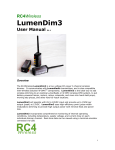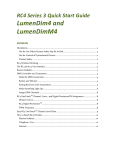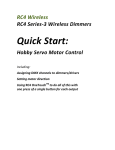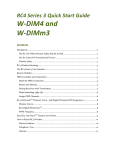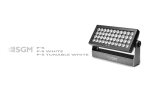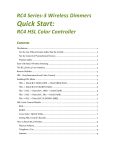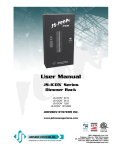Download W-DIM4 RDM - RC4 Wireless
Transcript
RC4Wireless W-DIM4 RDM User Manual R1.8 Overview The RC4Wireless W-DIM4 is a lowvoltage DC power 4-channel wireless dimmer. It communicates with Wireless Solution W-DMXTM transmitters. W-DIM4 is the ideal way to add wireless dimming to a W-DMXTM wireless DMX system and put battery-powered lamps, motors, relays, solenoids, and more into hand-held props, costumes, moving sets pieces, and other hard-to-reach or untethered locations. It operates with 6V to 30VDC power input and provides up to 180W per output (peak) at 12VDC, to a maximum combined total power of 500W. High-efficiency pwm (pulsewidth-modulation) dimming provides high output power with minimal heat and power loss. W-DIM4 incorporates comprehensive monitoring of internal operating conditions, including temperature, supply voltage, and current draw on each individual dimmer channel. The W-DIM dimmer card supports remote parameter configuration and real-time sensor monitoring using RDM (DMX Remote Device Management), including basic E1.20 and extended E1.37 RDM parameters. An RDM-capable Wireless Solution rf card must be installed to access RDM features via wireless. At the time of this writing, most W-DIM devices in the field are not equipped with RDM-capable cards. RC4 LumenDim4 User Manual Statements of Conformity This is a preliminary user manual. Comprehensive conformity statements are currently being prepared. All conformity requirements have been met, and the W-DIM4 may be used virtually anywhere in the world. FCC Statement Wireless Solution OEM RF cards are FCC listed and approved. Contact RC4 Wireless for additional information. Industry Canada Compliance Statement Wireless Solution OEM RF cards are IC approved. Contact RC4 Wireless for additional information. EC W-DIM4 devices for the European market are manufactured using a lead-free process and conform with all EC requirements. 2 RC4 LumenDim4 User Manual Disclaimers WIRING AND INSTALLATION OF BATTERIES, DIMMERS, AND LOADS MUST BE IN ACCORDANCE WITH APPLICABLE LOCAL AND NATIONAL ELECTRICAL CODES. Not for Use Where Human Safety May Be At Risk RC4 Wireless accepts no liability for direct, indirect, or consequential damages resulting from the use of any RC4 Wireless product or group of products. RC4 Wireless does not guarantee the suitability of any product for any purpose; user assumes all risk. RC4 dimmers must be used strictly in accordance with manufacturer's instructions and cannot be used for unsupervised operation. RC4 Wireless products must be installed and operated only by qualified technicians and should be inspected and tested on a regular basis to ensure proper operation. Not for Control of Pyrotechnical Devices RC4 Wireless dimmers should not be used to control pyrotechnics of any kind. A brief output surge during power-up could trigger these devices. RC4 Wireless accepts no liability if RC4 equipment is used for this or any other purpose. Product Safety RC4 dimmers are capable of controlling very large currents at up to 30VDC. Dimmers, wiring, and connectors should not be allowed to operate at dangerous temperatures. Appropriately sized wire and connectors must be used, along with suitable ventilation and external fuses rated for the load being operated. RC4 Wireless devices and equipment are operated at the user’s own risk and RC4 Wireless accepts no liability, either direct or consequential, as a result of using this equipment. 3 RC4 LumenDim4 User Manual Contents Overview ................................................................................................................................... 1 Statements of Conformity ............................................................................................................ 2 FCC Statement ......................................................................................................................... 2 Industry Canada Compliance Statement ...................................................................................... 2 EC .......................................................................................................................................... 2 Disclaimers ................................................................................................................................ 3 Not for Use Where Human Safety May Be At Risk ......................................................................... 3 Not for Control of Pyrotechnical Devices ...................................................................................... 3 Product Safety ......................................................................................................................... 3 Contents ....................................................................................................................................... 4 W-DIM4 Hook Up ........................................................................................................................ 5 DMX Connections ........................................................................................................................ 6 USB Connections ......................................................................................................................... 7 Controls, Indicators, and Settings ................................................................................................. 7 Link W-DIM4 to Your Transmitter ............................................................................................... 9 To Unlink ................................................................................................................................. 9 LEDs ..................................................................................................................................... 10 COP (Computer Operating Properly) Blink Patterns ..................................................................... 11 W-DIM4 Dimmer Test Mode ........................................................................................................ 12 Bump Buttons ........................................................................................................................ 12 Assigning DMX Channel and Dimmer Curves ................................................................................. 13 More About Dimmer Curves ........................................................................................................ 14 ISL and LEDs ......................................................................................................................... 14 ISL Slow: The Beauty of RC4 Digital Persistence......................................................................... 14 Linear and Incandescent Lamps ............................................................................................... 15 Non-Dim ............................................................................................................................... 15 Mixing ISL and Linear Outputs ................................................................................................. 15 Selecting the Right Dimmer Curve ............................................................................................ 15 Circuit Protection, Faults, and Errors............................................................................................ 16 Voltage ................................................................................................................................. 16 Temperature .......................................................................................................................... 16 Current ................................................................................................................................. 16 RDM (Remote Device Management) Functionality .......................................................................... 17 W-DIM4 Specifications ............................................................................................................... 17 RF ........................................................................................................................................ 18 Dimmers ............................................................................................................................... 18 How to Reach Us ....................................................................................................................... 19 Physical Address .................................................................................................................... 19 Telephone / Fax ..................................................................................................................... 19 Internet ................................................................................................................................ 19 4 RC4 LumenDim4 User Manual W-DIM4 Hook Up W-DIM4 is easy to connect and use. All wiring is done with Anderson Powerpole connectors. Input power, usually from 12V rechargeable batteries, enters on the RED+ and BLACK- terminals. Each of the 4 dimmer outputs has a YELLOW+ and GRAY- terminal for direct connection to load devices. The W-DIM4 will operate with input voltages from 6V to 30VDC. It is important that the supply voltage does not drop below 6V while dimmers are driving their full load. This can result in output flicker or oscillation: the logic comes on, activates the load, the supply voltage drops under load, the logic goes off, the load is turned off, the voltage rises, the logic comes back on… and so on. Maximum non-continuous output power for each dimmer channel is 180W. Avoid short circuits, which may damage the dimmer circuitry. Ensure adequate ventilation around the W-DIM4 to ensure dimmer heat can dissipate; avoid blocking the ventilation slots on the side and top of the unit. Prolonged operation at high temperatures can deform the case and damage the dimmer circuitry. Duty cycle influences maximum power. Given the ratings of the components, a 250W load could be handled by one channel for a brief time. But if a load is to be on for a significant period, then a draw of 150W or less is recommended. A fuse should always be installed at the battery terminals, and in each individual dimmer circuit. When operating all 4 dimmers with a 125W load at 12V, the total current draw from the battery is 41.5A. A 40A or 50A fuse should be used, positioned as close to the battery terminals as possible. A 15A fuse can be used on each dimmer output. When loads are smaller, fuses with lower capacities should be used. 5 RC4 LumenDim4 User Manual The gauge of wire used should be appropriate for the rating of the associated fuse. Follow local electrical codes, and never allow wire to run hotter than you can comfortably hold for several seconds. Anderson Pins, Shells, Crimping Tool More information about Anderson connectors is available at http://www.andersonpower.com/products/singlepole-connectors.html. DMX Connections The W-DIM4 features a 3.5mm 3-conductor “headphone” connector to deliver DMX data directly from the W-DMXTM rf receiver. With an appropriate adaptor cable, this port can be used to directly drive DMX devices. It can also be used for RF card firmware updates. Connections are: Sleeve = GND (DMX XLR pin 1) Ring = DMXA (DMX XLR pin 3) Tip = DMXB (DMX XLR pin 2) 6 RC4 LumenDim4 User Manual USB Connections The USB port on the W-DIM4 is no longer supported. Monitoring and remote configuration features are now accessed via industry-standard RDM (DMX Remote Device Management). [The remainder of this page is intentionally blank.] 7 RC4 LumenDim4 User Manual Controls, Indicators, and Settings All W-DIM4 pushbuttons and indicators are recessed under holes in the case. Each dimmer channel has a pushbutton, marked A, B, C, and D, and an LED power output indicator positioned directly below each dimmer button. There is also a Shift Func: Set Chan button with the COP (Computer Operating Properly) indicator below it, and an RF Sync/Disconnect button with the RF LINK indicator below it. Pushbuttons are marked on the W-DIM4 label with a triangle pointer. Use a bent paperclip, needle, or other thin pointer to operate these buttons. Other holes are LED indicators. DO NOT PUSH ANYTHING INTO THESE HOLES. Doing so may damage the unit. The RF Sync button works the same way as the Connect or Link button on any W-DMXTM device. Use this button to link the W-DIM4 with your transmitter. Below the RF Sync button is the RF LINK indicator, which is on, off, or blinking depending on the W-DMXTM mode. See Wireless Solution W-DMXTM documentation for additional information. 8 RC4 LumenDim4 User Manual Link W-DIM4 to Your Transmitter 1. Ensure antennas are connected to all devices. 2. Power on the transmitter and W-DIM4. Ensure that the RF indicator is off on all receivers (use the Unlink procedure if necessary). 3. On the transmitter, press and release the FUNCTION button. The transmitter will search (for a period of ten seconds) for unlinked receivers. The W-DIM4 RF indicator will flash. 4. While the RF indicator is blinking, press and release the RF Sync button on the W-DIM4. At the end of the transmitter search period, the W-DIM4 will be linked to the transmitter and the RF indicator will be on. If DMX data is present, the DMX indicator will also be on. To Unlink To unlink the W-DIM4: Press and hold the RF Sync/Disconnect button for several second. The RF indicator will go off when it unlinks. 9 RC4 LumenDim4 User Manual LEDs The red power indicator is at the far left below the DMX miniplug. It denotes 5V power on the W-DIM4 logic board. This indicator should always be lit when the unit is powered on. Beside the power indicator is the yellow DMX indicator. It is below and to the right of the DMX miniplug. It is on when the internal W-DMXTM receiver board is generating valid DMX data packets. This indicator will be off if the W-DMX receiver is not connected with a transmitter, or if there is no DMX data going into the connected transmitter. Next is the blue RF LINK indicator, which is directly below the RF Sync/Disconnect pushbutton. The green COP (Computer Operating Properly) indicator is located below the Func Shift: Set Chan button. The DimA, DimB, DimC, and DimD indicators are driven by actual power at the output of each dimmer. They are positioned below each associated dimmer Set button marked A, B, C, and D. 10 RC4 LumenDim4 User Manual COP (Computer Operating Properly) Blink Patterns The COP indicator blinks slowly to indicate normal operation. It will blink rapidly when an RDM Identify command is received, allowing this particular unit to be found in a complex RDM system. [The remainder of this page is intentionally blank.] 11 RC4 LumenDim4 User Manual W-DIM4 Dimmer Test Mode Bump Buttons The button for each dimmer will momentarily turn the dimmer on at 75% while pressed. The associated dimmer indicator (Dim A – D) will come on, along with the connected load. Each dimmer indicator is immediately below the associated dimmer bump button. Use these bump buttons and indicators to check wiring, connections, and lamps. Dimmer bump buttons can be used to test dimmers and loads, even when no transmitter is connected. 12 RC4 LumenDim4 User Manual Assigning DMX Channel and Dimmer Curves Channel setup requires a W-DMXTM (or compatible) transmitter, and a DMX data source. To assign DMX channels and dimmer curves using the hardware pushbuttons on the W-DIM4, you must be able to bring up one DMX channel at a time to a specific level. A portable Goddard DMXter, Fleenor Gizmo, BIC Pocket Console DMX or other similar device can be used if your regular console is inconvenient for this purpose. You need two small pointer tools. Bent paperclips are ideal. Two recessed buttons must be pressed simultaneously to change a DMX channel assignment. When you press the appropriate pair of buttons on the W-DIM4, it determines the lowest channel that is currently on, and what level it is at. That channel can be assigned to any dimmer(s), and the level of the channel determines which dimmer curve will be used. Here is the procedure: 1. Zero all DMX channels. 1. Bring up the level of a single channel you wish to assign to a DMX4dim dimmer. This is the channel you will be assigning to the dimmer. The level you use determines the dimmer curve that will be assigned: Non-dim: 100% (75% or higher) Linear dimming: 66% (50% to 74%) Inverse-square-law (ISL) with Smoothing: 33% (25% to 49%) 2. With the desired channel up at the transmitter, go to the W-DIM4 receiver-dimmer. Press and HOLD the Func Shift: Set Chan button while momentarily pressing the button for the dimmer you wish to assign. That is, the A, B, C, or D button. For example, to assign the currently active DMX channel to dimmer C, hold Func Shift and tap the C button. The dimmer will come on when you press the dimmer button, and is now assigned and responding to the selected DMX channel. Again, note that the level of the channel determines the dimmer curve use by W-DIM4 for that dimmer output. The W-DIM4 will remember the channel assignments and dimmer curves until you decide to change them. Each channel can have a completely unique dimmer channel and curve. It’s easiest to set channels using two hands. 13 RC4 LumenDim4 User Manual More About Dimmer Curves ISL and LEDs W-DIM4 pwm dimmers are capable of very high resolution, making them ideal for smoothly dimming LEDs. To look smooth to the human eye, LEDs must be dimmed with an Inverse Square Law (ISL) curve, demanding very small changes in level at the bottom of the curve. At maximum resolution, W-DIM4 can deliver ISL dimming with 65,536 steps (16 bit resolution), so a single step change represents 0.0015% of full level. Compare this to standard linear DMX dimmers with 256 steps that each represent 0.39% of full level. In ISL mode, W-DIM4 updates pwm levels at a default frequency of 600 times per second (600 Hz). Compare this to the 60 Hz power line driving conventional fixtures. This speed is fast enough to avoid strobing and shimmering that is sometimes evident using other less sophisticated dimmers. The disadvantage of updating at 600 Hz is that it can be audible. If an incandescent lamp is used with the ISL curve, the filament will noticeably “sing”. LEDs are solid state – no moving parts – so they do not sing. Using RDM (DMX Remote Device Management), parameters are available for pwm frequency (up to several kHz), and smoothing rate (RC4 Digital Persistence). ISL Smoothing: The Beauty of RC4 Digital Persistence Because LEDs have no inherent filament persistence and respond quickly to changes in power level, low resolution dimming (with a small number of steps) results in noticeable jumps in LED brightness, particularly when viewed peripherally. RC4 Digital Persistence smoothing is provided with the ISL curve. Smoothing makes use of the high-resolution of RC4 dimmers by gliding through all available steps. Although DMX channels provide a range of only 256 steps (0 – 255), having a higher resolution at the dimmer ensures accuracy at the bottom of the ISL curve where changes in power level are very small. Be default, the ISL curve provides a moderate glide time to emulate the filament of a typical MR11 lamp. Using RDM (DMX Remote Device Management), parameters are available for pwm frequency (up to several kHz), and a range of smoothing rates (RC4 Digital Persistence). If you are using Red or other high-resolution video cameras, use RDM to set the pwm frequency at the highest frequency you find necessary to avoid visible flicker. The W-DIM4 pwm engine is capable of frequencies far higher than required for flicker free capture with a Red camera. 14 RC4 LumenDim4 User Manual Linear and Incandescent Lamps When a linear dimming curve is used with an incandescent lamp, low lamp noise and high electrical efficiency are achieved by using a low pwm frequency of 75 Hz. This is similar to 50/60 Hz AC dimmers. Non-Dim Some loads, particularly relays, solenoids, and DC-AC power inverters, should be driven with simple on/off non-dim power. The non-dim curve ensures this, and includes level hysteresis: the source dmx level must rise about 53% to turn on, and drop below 47% to turn off. Thus, the dimmer will not oscillate on and off if the source signal is jittery and/or rises and falls slowly. Mixing ISL and Linear Outputs Each individual W-DIM4 dimmer is independently configurable. Any combination of ISL, Linear, and Non-Dim outputs may be used simultaneously, and each can be configured with independent DMX channel, curve, pwm frequency, and RC4 Digital Persistence smoothing rate. Selecting the Right Dimmer Curve When setting dimmer channels and curves with the W-DIM4 pushbuttons, channel level ranges provide the following curves: Dimmer Curve Non-Dim Linear ISL Slow, RC4 Digital Persistence Level Percentage 100% (70%+) 66% (50% - 74%) 33% (25% - 49%) Level Dec (0-255) 255 (192+) 160 (128-191) 80 (64-127) Level in Hex (0-FF) 0xFF (0xC0 or higher) 0xA0 (0x80-0xBF) 0x50 (0x40-0x7F) Use ISL for LED devices. This curve provides RC4 Digital Persistence to emulate the filament persistence of a typical MR11 incandescent lamp. Linear is ideal for incandescent loads, including MR16s and MR11s. Non-Dim is intended for use with relays, solenoids, air brakes, and other on/off devices. Hysteresis ensures there will be no noise or oscillation, even if the source DMX level is slowly changing or is noisy. The DMX level must rise above 54% (dec 138, hex 0x8A) to turn on. Then, the level must fall below 46% (dec 117, hex 0x75) to turn off. Use RDM (DMX Remote Device Management) E1.37 parameters for pwm frequency (up to several kHz), and a range of smoothing rates (RC4 Digital Persistence). Use slow smoothing to make large LED look smoother; use faster smoothing to keep blinks, flashes, and strobing looking more immediate and eyecatching. 15 RC4 LumenDim4 User Manual Circuit Protection, Faults, and Errors To avoid damage to internal electronics, the W-DIM4 constantly monitors voltage, temperature and current. In the event of a fault condition, dimmer outputs may disable themselves. Voltage The W-DIM4 monitors the power supply for both over- and under-voltage. Voltage higher than 31VDC will cause all dimmers to shut down until voltage drops back down below 30V. RDM sensing provides access to the current voltage, as well as the highest and lowest voltages detected since the last device power-up. Allowing 12V lead-acid batteries to drop below 10VDC under load will cause permanent battery damage – they will never fully recover their maximum capacity. Temperature A temperature sensor measures the temperature of circuit-board traces carrying high currents to the four W-DIM4 dimmers. If these traces exceed 240F (degrees Fahrenheit) all dimmer outputs will be disabled until the temperature drops below 210F. RDM sensing provides access to the current temperature, as well as the highest and lowest temperatures detected since the last device power-up. Current Current flow is monitored individually for each W-DIM4 dimmer. If current rises above 20A, the dimmer is disabled and turned off. A disabled dimmer can be reset by either: 1. Turning the W-DIM4 off and back on, to reset the unit. 2. Clearing the DMX level driving the disabled dimmer. When the DMX level drops to zero, the over-current error is cleared. RDM sensing provides access an immediate current reading, as well as the highest and lowest current draw detected since the last device power-up. 16 RC4 LumenDim4 User Manual RDM (Remote Device Management) Functionality Wireless Solution W-DMXTM rf modules used in W-DIM4 units are RDM capable. RDM features supported by the radio itself are available immediately, regardless of the firmware version in the W-DIM4. The microprocessor used in the W-DIM4 is a high-speed and powerful DSP (digital signal processor). It provides extensive RDM support without impacting simultaneous real-time dimmer performance. The W-DIM4 appears as an RDM Root Device, and 4 Subdevices. RDM Root Device Parameters Supported Include: E120_PRODUCT_DETAIL_ID_LIST E120_DEVICE_MODEL_DESCRIPTION E120_MANUFACTURER_LABEL E120_DEVICE_LABEL E137_1_DMX_BLOCK_ADDRESS E120_SENSOR_DEFINITION E120_SENSOR_VALUE E137_1_IDENTIFY_MODE E120_FACTORY_DEFAULTS E120_RESET_DEVICE RDM Subdevice Parameters Supported Include: E120_DEVICE_LABEL E137_1_CURVE E137_1_CURVE_DESCRIPTION E137_1_OUTPUT_RESPONSE_TIME E137_1_OUTPUT_RESPONSE_TIME_DESCRIPTION E137_1_MODULATION_FREQUENCY E137_1_MODULATION_FREQUENCY_DESCRIPTION E120_SENSOR_DEFINITION E120_SENSOR_VALUE Mandatory RDM Parameters may not be listed above, but are fully supported to ensure compliance with RDM specifications. CURVE selects Non-Dim, Linear, or ISL dimming curves. OUTPUT_RESPONSE_TIME adjusts RC4 Digital Persistence rate with a range of 8 settings from OFF (No Smoothing) to Very Slow. MODULATION_FREQUENCY selects dimmer pwm frequency over a range of options. 17 RC4 LumenDim4 User Manual W-DIM4 Specifications RF Please see Wireless Solution W-DMXTM RF specifications for complete details. Dimmers Power Input: 6VDC – 30VDC (12V typical), 90 mA minimum, plus requirements of connected dimmer loads. Dimmer Outputs: 4 individual dimmer channels, each with independently assignable DMX channel and dimmer curve. PWM Resolution: PWM Frequency (Linear Curve): PWM Frequency (ISL Curve): 65,536 steps (16-bit) 75 Hz 600 Hz Dimmer Technology: MOSFET PWM (pulse-widthmodulation) Absolute Maximum Output Current per Dimmer: 42A (pulse only) Absolute Maximum Input Voltage: 31VDC Typical Continuous Output Current per Dimmer: 12.5A Typical Maximum Continuous Output Power: Maximum Total Output Power (4 Dimmers Combined) 150W per channel 500W total * * RELIABLE TOTAL OUTPUT POWER IS LIMITED BY DUTY CYCLE, AMBIENT TEMPERATURE, AND CIRCUIT-BOARD TRACE WIDTHS. High ambient temperatures and blocked ventilation slots, among other things, will reduce the maximum total output power that can be sustained before a thermal shutdown occurs. 18 RC4 LumenDim4 User Manual How to Reach Us Physical Address RC4 Wireless is a registered trade-name of Soundsculpture Incorporated Soundsculpture Incorporated 13604 Heathwood Court Raleigh, NC, 27615 USA Telephone / Fax Toll Free Office 1-866-258-4577 (North America only) Toll Free Fax 1-866-237-6641 (North America only) London, UK, +44 (0)20 3289 8765 USA Office 919-229-9950 USA Emergency Cellular 919-400-3961 Internet Email [email protected] Skype theatrewireless Website www.theatrewireless.com 19 RC4 LumenDim4 User Manual RC4, RC4Wireless, W-DIM4 and the RC4 logo are trademarks of Soundsculpture Incorporated. W-DIM4 RDM User Manual R1.8 Jun-2013 JDS 20




















